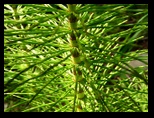
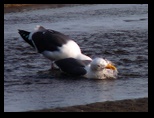


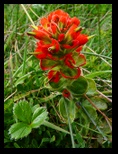
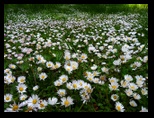
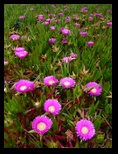
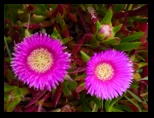


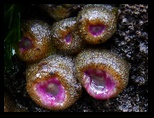
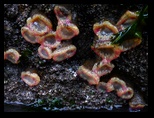
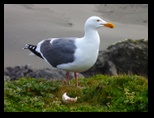
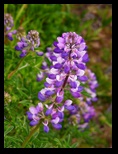




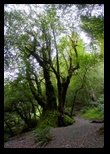
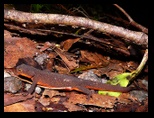
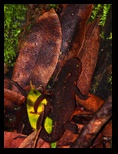
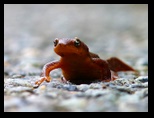
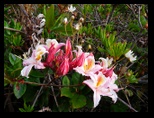






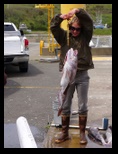
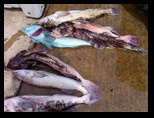
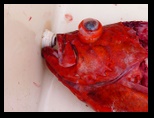

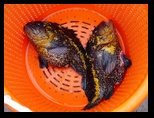
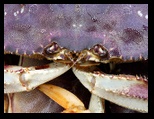
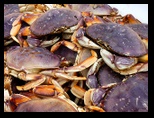
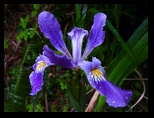

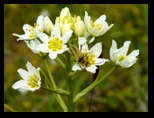

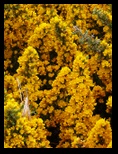



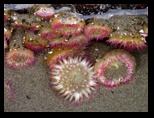


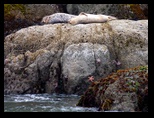





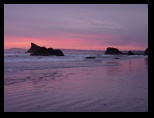
Click on a photo to enlarge it.
Although we have driven through Oregon numerous times we have never been along the coast. It was already quite late when we finally
arrived at our first stop Brookings and only made it to the visitor centre five minutes before closing.
We picked up the information we needed including a mile by mile guide for the entire coast which was exactly what we needed. The couple
in the visitor centre even drove ahead of us to show us a good place to stop for the night. Very helpful!
Sunset was around 9pm so we still had time to go to Harris Beach State Park for photos. Helen didn't watch out for the waves
and promptly got her new trainers wet and had to put them on Winnie's bonnet to dry out!
Oregon has not had very good weather so far this year and it has been wetter than normal, but we found that the weather wasn't
too bad with enough sun to be able to do a lot of walking and for Kirsten to get her sunset photos. There is also a coastal trail
that runs along most of the coast. Some of it goes along the beaches but there are other stretches along the cliffs, through forests
and connects all the State Parks and numerous other scenic areas.
We loved the coast right from the start and wondered why it had taken us so long to get here.
The next day we went to the Samuel H Boardman Scenic Corridor which runs along a 12 mile stretch of coast with various viewpoints and
trails. All of the trails tend to be steep but we were mesmerised by the waves crashing against the rocks and into the many coves.
We stayed overnight at Myers Creek Viewpoint for sunset photos and the first of many photos of sea anemones.
It was foggy the next day so we spent most of it in the library catching up on work and doing the washing up. But it cleared up later
so we did the Myrtle Tree Trail to see the largest Myrtle tree in Oregon which is over 400 years old (actual age unknown).
In Oregon, this tree is known as Oregon Myrtle, while in California it is called California Bay Laurel. This hardwood species is only
found on the Southern Oregon and Northern California Coast. Myrtlewood is considered a world-class tonewood and is sought after by
luthiers and woodworkers from around the world and the wood is used to make all sorts of artefacts including bowls, spoons, chopping
boards and lamp stands.
The real treat was what we thought at first was a salamander but we found out later to be a rough-skinned newt. Perfectly camouflaged
with its mud brown top coat it was only because it moved and Helen saw its orange underbelly that we even found it. Kirsten got up
close and personal to take photos and we found out later that it is highly toxic.
The rough-skinned newt is a North American newt known for its strong poison. Many newts produce toxins to avoid predation, but the
toxins of the rough-skinned newt are particularly potent. Toxicity is generally experienced only if the newt is ingested. It has the
effect of inducing paralysis and death.
We had driven along the banks of the Rogue River to get there and saw a bald eagle. We returned to the coast and went to Otter Point
State Park which has some good sandstone formations and rocks.
It rained the next day but we didn't let the weather stop us. We went to Port Orford which is the only open water port on the Oregon
coast and one of six "dolly" ports in the world where recreational and commercial fishing boats are hoisted into and out of the harbour
by a type of crane called a dolly.
We talked to the dolly operator and found out that the job is not easy and needs a lot of concentration. Numerous problems can happen
especially when the waves are high or at low tide when the boats have to be as far way as possible to prevent being crashed against
the quay and the dolly has to swing the boats around onto the dock.
The dolly operates 24 hours in three shifts but the night operator is just on call. They don't earn very much either!
We also talked to a woman who works for Oregon fisheries and was recording the weight and size of the fish caught by sports fishermen
for the purposes of protecting the numbers of fish. A great source of information for us as we had never seen most of these type of
fish before. One type was a blue cod which literally has blue flesh inside.
The fishermen get $6 per pound for a China Rock fish which is twice as much as for other fish. Another favourite is the Dungeness
Crab, a delicacy on the coast here.
Dolly Docks in Port Orford
We went to Port Orford Heads State Park and did a "boot march" along a headland trail as it was threatening to rain again. Then it
was off to a restaurant for fish and chips - very appropriate you might think except that the real reason was because the chicken we
had taken out of the freezer was still frozen!
We went to Norwegian owned restaurant and the fish and chips were great but the cod came from Alaska!! Oh well, so much for local fish!
The Triple Berry pie and ice cream made up for any disappointment!
It had rained on and off for most of the day and then it poured. Winnie couldn't keep out the water and we started leaking again in
the usual places. We used tea towels to soak it up until we can get onto the roof to put more aluminium tape on and hope that we cover
the place where the leak is. But we can't do that in the rain.
Fortunately it was dry the next day and we walked along various trails at New River Area of Critical Concern looking for birds that
weren't there! But we did see some cranberry bogs.
We drove to Bandon State Park and Face Rock where the cliffs are strewn with gorse bushes that are in flower right now and bright
yellow and then to Coquille Point to see the tidal pools with sea anemones and star fish and all the seals on the rocks.
The harbour seal, also known as the common seal, is a true seal found along temperate and Arctic marine coastlines of the Northern
Hemisphere. They are found in coastal waters of the northern Atlantic and Pacific Oceans, as well as those of the Baltic and North
Seas, making them the most widely distributed of the pinnipeds (walruses, eared seals, and true seals).
Common seals are brown, tan, or gray, with distinctive V-shaped nostrils. An adult can attain a length of 1.85 meters (6.1 ft) and
a mass of 132 kilograms (290 lb). Females outlive males (30 to 35 years versus 20 to 25 years). Common seals stick to familiar
resting spots or haul out sites, generally rocky areas (although ice, sand and mud may also be used) where they are protected from
adverse weather conditions and predation, near a foraging area. Males may fight over mates underwater and on land. Females are
believed to mate with the strongest males and generally bear a single pup, which they care for alone. Pups are able to swim and
dive within hours of birth, and they develop quickly on their mothers' fat-rich milk. A fatty tissue layer called blubber is present
under their skins and helps to maintain body temperature.
Their global population is 5-6 million, but subspecies in certain habitats are threatened. Seal hunting or sealing, once a common
practice, is now illegal in most nations within the animal's range.